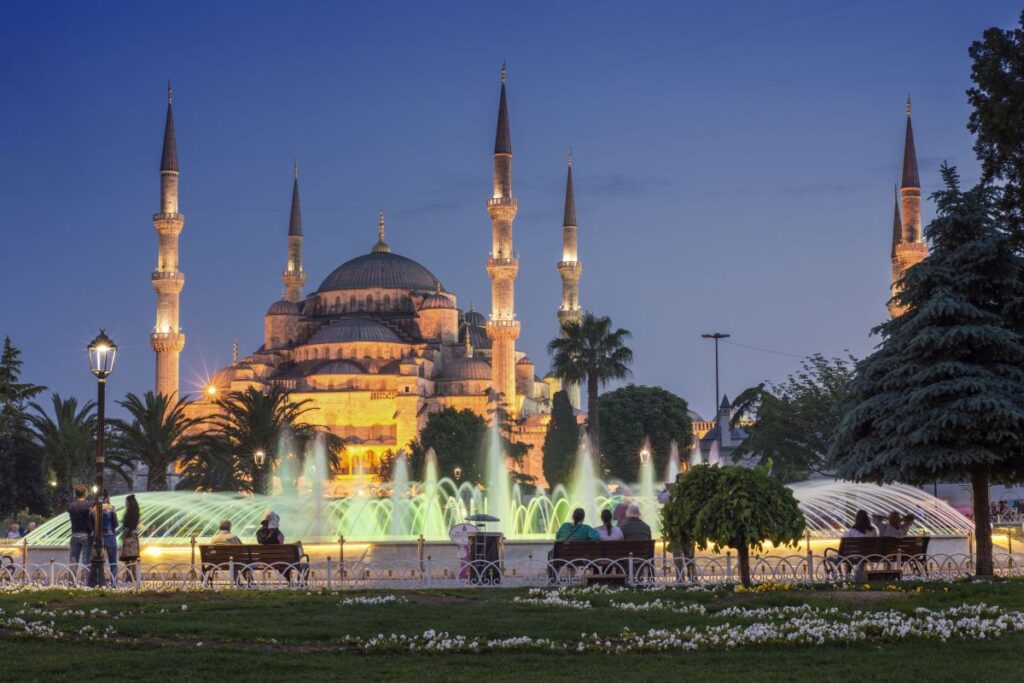The blue Mosque. It is the most famous and visited by tourists who travel to Istanbul . Its magnificent exterior is a true symphony of beautiful blue Izmir mosaics, giving this space a very special atmosphere .

Etymology of the name
It owes its name to the vivid blue and green color of the 20,000 Iznik tiles that decorate the domes and upper part of the Mosque.
Location
It is located opposite the Church of Hagia Sophia, in the center of the city and very close to the Topkapi Palace, this proximity to the palace was one of the main reasons why this place was chosen for its construction. Also from this point of the city you could dominate the two seas that surround the city.
History of its construction
Also known as the Sultanahmed Mosque or Sultanahmed Camii, it was built during the reign of the fourteenth Ottoman Sultan, Ahmed I, between 1609 and 1616 . It was built by the disciple of the architect Mimar Sinan, Sedefkar Mehmet Ağa. Its construction, begun in 1609 , ended in 1616 . The mosque was built together with a madrassa, a Koranic school, an asylum, a place for the sale of handicrafts , a kervansaray, accommodation for camels , a fountain and a külliye, a social and religious complex.
Sultan Ahmet ascended the throne at the age of fourteen and ruled with great popular acceptance until the age of twenty-eight; he passed away just a few weeks after the mosque was inaugurated. He is buried in the Külliye of his own mosque .
The architect of the mosque, Mehmet Ağa received the nickname Sedefkar, the marketeer. The place chosen for the construction of the mosque was controversial because, being located near Santa Sofia, it required the demolition of part of the royal palace and the hippodrome. Another particular one that caused controversy was that this mosque could not be paid with the spoils of war (as was the custom), because the imperial troops were defeated by the Persian Abbas the Great who took Iraq and Azerbaijan from the Ottomans, so It had to be paid for through tax collection, something that Islamic law does not allow. The care they showed in choosing the site is a reflection of the subsequent care they put into choosing the construction materials and the decoration of the mosque. The 20,000 tiles Iznik used in its construction were made in the palace workshops; the carpets of hundreds of square meters were woven on looms and crystal imperial of oil lamps were brought from abroad. Although the architect Mehmet Ağa did not achieve the large and illuminated interior spaces of his teacher Mimar Sinan, the Blue Mosque constitutes one of the best representations of the decorative motifs of Istanbul .
Architecture
Exterior
There are five doors to enter the outer courtyard of the mosque. The front patio, which is accessed by stairs, has five entrances. On the north side, below the inner courtyard, are the ablution fountains. In the center of the courtyard is a magnificent şardivan, ablution fountain, hexagonal in shape with six granite columns that form the peristyle, seven on one side and eight on the other, there are thirty small domes built. On the southeast side of the palace a ramp was built so that the Sultan could reach his pavilion. The Sultan Ahmet Mosque is the only one in Istanbul and Turkey that has six minarets, which gives it a special value among Ottoman mosques.
The four minarets at the corners each have three balconies, those in the courtyard only have two. According to legend, Sultan Ahmed I asked the architect for a mosque with gold minarets , but due to the high cost he preferred to increase the number to six.
Inside
There are a total of 260 windows in the mosque. The dome, 23.5 m in diameter, culminates at 43 m and rests on four pointed arches and four flat pendentives; It is supported by four huge fluted columns of 5 m in diameter, divided at half height by a ring. The black stone located in the mihrab was brought from Kaaba, the holy city of the Muslims . Next to the mihrab is the minbar, a kind of pulpit, a beautiful example of Ottoman sculpture, which was used to give sermons.
The Müezzin Mahfili, which is located in front of the minbar, is a copy of Mecca. On the left side is the Hünkar Mahfili or imperial gallery, a place where the sultan prayed. The calligraphies that surround and decorate the dome, semi-domes and columns contain Qur’anic verses and sentences of the prophet Muhammad. The valuable rugs of various colors that covered the floor of the mosque have until recently been exchanged for other rugs of lesser value.
Except for the wall of the Kibla, the three galleries dedicated to the use of women and religious gatherings open on the other walls. To the northeast of the mosque is the great Türbe, a square mausoleum with a courtyard in front, built by Sultan Osman II, son of Sultan Ahmed I. Here lie Ahmed I, his beloved wife Kösem Maypeyker and three of their children: Osman II, Murat IV and Bayezid I .
